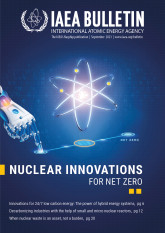
If you would like to learn more about the IAEA’s work, sign up for our weekly updates containing our most important news, multimedia and more.
Fuelling the Future: Building Fuel Supply Chains for SMRs and Advanced Reactors
Lucy Ashton

The United States Department of Energy has invested in the domestic production of high assay low enriched uranium (HALEU) fuel. The HALEU demonstration programme based in Piketon, Ohio, is expected to produce 20 kilograms of HALEU by the end of 2023. (Photo: Centrus Energy Corporation)
Engineers are preparing for the next generation of nuclear power reactors, aimed at improving energy security and mitigating climate change. Many advanced reactor designs, including small modular reactors (SMRs), will require high assay low enriched uranium (HALEU) fuel, which ranges from 5 to 20 per cent of uranium-235 — beyond the 5 per cent level that powers most nuclear power plants in operation.
“HALEU fuel will enable smaller designs, longer operating cycles and increased efficiencies,” said Olena Mykolaichuk, Director of the Division of Nuclear Fuel Cycle and Waste Technology at the IAEA. “However, in order to reap the full benefits of HALEU fuel, some countries are boosting production capacity to ensure that sufficient supply is available, which will be critical for SMR deployment.”
The next generation of nuclear technologies will require new supply chains for new kinds of fuel.
HALEU is produced in the Russian Federation and the United States of America, mostly for use in research reactors and for possible use in operating light water reactors. The facility in Russia is currently the only one that manufactures HALEU on a commercial scale.
Last year, the Euratom Supply Agency produced a report on the future fuel supply for Europe’s HALEU-converted, or soon to be converted, research reactors. Traditionally, Europe’s research reactors have been fuelled by high enriched uranium. HALEU-converted research reactors are currently supplied with fuel from Russia and the USA, and the latter says that it can only guarantee this supply until 2035 or 2040, due to the current lack of HALEU production capabilities, which increases the risk of supply shortage for the research reactors to be converted in the future.
The Euratom Supply Agency estimates that, by 2035, the European Union will need between 700 kilograms and a ton of HALEU each year to keep its research reactors in operation. This estimate does not include any future demand from advanced reactors used for power generation. Euratom therefore recommends that the EU develop its own capacity to produce HALEU fuel, due to concerns over the future security of supplies.
While HALEU production is not yet on the horizon in Europe, the continent’s largest nuclear fuel producers are world leaders in enrichment technology. These producers currently enrich uranium up to 6 per cent and, according to the Euratom Supply Agency’s report, could use the same technology to produce HALEU without major technical challenges.
However, the licensing, building, securing and operation of such facilities requires significant investment, and European producers say they still need to see the business case for that investment. European companies could start producing HALEU in as little as five years and plans for the expansion of an existing French plant, plus the construction of new facilities in the United Kingdom and the USA are under consideration.
Nevertheless, the US nuclear industry is warning that the deployment of some SMR designs may be delayed by years due to the lack of HALEU. Currently, nine out of ten advanced reactor designs funded by the US Government will need HALEU fuel in the next decade. Projections by the US Department of Energy (DOE) suggest that more than 40 000 kilograms of HALEU will be needed by 2030, with that amount set to grow year after year as the new fleet of advanced reactors is put into operation.
Working to address this need, the US DOE is investing in the domestic HALEU production line. It has set up a HALEU Consortium and has co-funded a demonstration production plant in Piketon, Ohio. In June 2023, the US regulator cleared the Piketon facility to begin enrichment operations.
Piketon’s HALEU centrifuge cascade is expected to produce 20 kilograms of HALEU by the end of 2023 and 900 kilograms in 2024. A full-scale HALEU cascade of 120 individual centrifuge machines has a combined capacity of approximately 6000 kilograms of HALEU per year.
To complement this, another type of HALEU fuel is beginning to be produced for use by down-blending government stockpiles of high enriched uranium. Tristructural isotropic (TRISO) particle fuel is made of uranium, carbon and oxygen covered in three layers of carbon- and ceramic-based materials that prevent the release of radioactive fission products. These particles can then be shaped into either billiard ball sized spheres called pebbles or cylindrical pellets. TRISO-HALEU fuel is used in high temperature gas cooled reactors, and some vendors are planning to use TRISO-HALEU fuel for their SMR and microreactor designs.
“The next generation of nuclear technologies will require new supply chains for new kinds of fuel,” said Ki Seob Sim, Nuclear Fuel Engineering Specialist at the IAEA. “Efforts are now underway to build out those supply chains, but a lot more remains to be done, including demonstrating a clear business case for these advanced reactors in many regions, if we are to ensure the necessary supply of HALEU fuel. However, I’m confident that we can do that.”
Related stories
Related resources
- IAEA Scientific Forum 2023, 26 – 27 September 2023
- Nuclear Innovations for Net Zero, IAEA Bulletin (Vol. 64/3, September 2023)
- Nuclear Power and the Clean Energy Transition, IAEA Bulletin (61-3, September 2020)
- Nuclear Explained – Nuclear Reactors and the Future of Nuclear Power, Part II
- Department of Nuclear Energy






